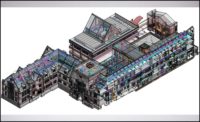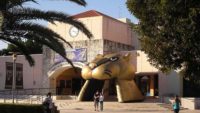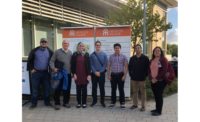Persistently high, recurring operational costs are widely recognized as an especially significant issue for lab facilities. During the summer of 2019, Florida State University (FSU) initiated a competitive selection process to engage design and commissioning providers to retro-commission existing research laboratories and improve their energy performance. This effort was part of a larger-scale progressive program led by FSU Utilities and Engineering Services to increase safety, efficiency, and sustainability within FSU’s existing laboratory facilities.
“The new light commissioning process for laboratories supports the university’s efforts to operate top performing research labs,” said Jim Stephens, executive director of utilities, maintenance, and engineering. “It is consistent with the efforts that have driven Florida State University to be a top 20 public research institution.”
This specific process was conceived as a coordinated effort by the consultant, departmental staff, and building managers in three steps: 1) identify and document modifications to original designs, 2) verify existing airflow and pressure measurement within the lab rooms, and 3) adjust the air change rates of existing labs per current university standards.
AEI’s understanding of FSU’s pragmatic approach to optimizing laboratory system performance and extensive experience nationwide on “smart lab” projects served as the basis supporting this effort. As a result, AEI helped FSU optimize air change rates, improve safety and comfort, and streamline maintenance in individual lab spaces. Proactive communication and extensive experience with lab facilities on the consultant’s part were also critical due to the presence of ongoing research in laboratories; both safety and research integrity were recognized to be at risk with any unplanned adjustments to the HVAC system.
AEI previously developed a vendor-neutral lab retro-commissioning process based on standards developed by Lawrence Berkeley National Laboratory and the U.S. Department of Veterans Affairs and made subsequent enhancements using lessons learned through millions of square feet of lab retro-commissioning. AEI’s approach was to tailor its existing methodology to the scope of work outlined by FSU. Specifically, this approach included the functional testing of devices and instrumentation, building consensus with FSU stakeholders to strategically reduce air change rates based on quantitative data, and engaging the FSU team with additional training in context of this project. Most importantly, AEI brought a broad, deep history with lab design and commissioning that proved critical for recognizing and quickly responding to highly technical issues associated with ongoing operations in scientific research facilities.
Past projects showed that AEI’s approach to retro-commissioning yields many recommendations with low or instantaneous economic payback that can be implemented in consensus with operations staff and sustained in the future as shown by the progression in Figure 1. Using this time-proven approach combined with AEI’s unique experience and specialized capabilities led to the successful execution of this project in support of FSU’s vision for safe, functional, efficient, and well-documented labs. This case study summarizes how AEI and FSU collaborated on two distinct lab facilities and presents results for each.
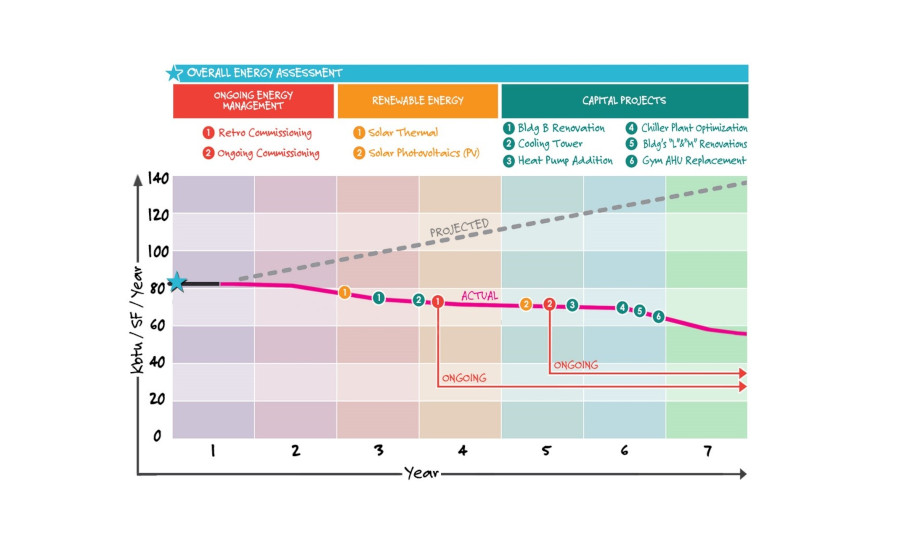
Sustained effects of commissioning in existing buildings.
FSU’s three-step approach to the retro-commissioning process, as identified in their request for proposals, consisted of the following activities.
1. Initial Site Observation and Information Gathering
a. Identify any ongoing maintenance work orders, contractor projects, renovations, or problems in the building and ensure all maintenance issues and repairs are resolved before commissioning.
b. Visually inspect the equipment on the roof and that above the ceiling for any existing maintenance problems.
c. Visit each room to verify record documents and determine if any changes have been made to the original design.
2. Assessment
a. Terminal Equipment Assessment
Confirm configuration for the application is correct in accordance with project records and the manufacturer for each space.
• Assess the general condition and verify performance in accordance with performance documentation from the original installation. Identify any failed components, including leaks and fouled strainers, or modifications to the original design.
• Perform manufacturer-recommended diagnostics for controllers to verify operation in accordance with the design documents.
b. Sensor Verification and Functional Performance Testing
• Calibrate the flow measurement devices for supply, general exhaust, and fume hood exhaust as applicable; identify any controllers and/or flow sensors that cannot be calibrated to manufacturer-specified tolerance.
• Recalibrate or repair any under-performing fume hood sash sensors.
• Identify any temperature or humidity sensors that need to be replaced to ensure accuracy using campus-standard instrumentation.
• Identify any occupancy sensors used for the HVAC control that need to be repaired or replaced.
c. Alarm and Graphics Verification
• Document all existing alarms on the building control system as found, including the specific network address.
• Verify that building control system graphics appropriately reflect the actual installation and that alarms function as designed.
d. Fume Hood Verification
• Verify appropriate system response to emergency purge command, i.e., fully open damper and maximum exhaust flow.
• Verify functionality compared to the original sequences of operations for fume hoods and room ventilation controls.
• Record fume hood exhaust airflow and face velocity using a hot wire anemometer in accordance with ASHRAE 110 requirements.
• Record airflow at the respective exhaust fans and air-handling unit while all hoods are closed. Open fume hood sashes sequentially and record the resulting airflow of the exhaust fans and air-handling unit.
3. Adjustment and Verification
With the full completion of Section II commissioning, including the replacement of failed components and recalibration, execute the following.
a. Terminal Equipment Controls
• Implement airflow set point changes for modified air change rates as prescribed by FSU; verify response of the terminal devices and graphic displays.
• Repeat the commissioning process for airflows.
• Verify offset airflow rates at each terminal controller and the corresponding pressurization in each lab space.
b. Fume Hoods
• Adjust airflow set points in coordination with other terminal devices, corresponding to modified air change rates, and verify response of the terminal devices’ graphic displays.
• After adjusting the air change rates, record the fume hood exhaust airflow and face velocity using a hot wire anemometer in accordance with ASHRAE 110 requirements.
• Record airflow at the respective exhaust fans and air-handling unit while all the hoods are closed. Open the fume hood sashes sequentially and record the resulting airflow of exhaust fans and air-handling unit.
This retro-commissioning process was also intended to integrate FSU Utilities and Engineering Services’ previously developed Research Lab Standard (RLS) form.
“The RLS was created to formally document the airflow settings within each respective lab space and to ensure that any proposed changes to airflow set points or to the overall design of lab airflow systems was recorded for future reference,” said Jackie Bucheck, the campus lab/air resources manager.
The RLS form allows FSU Utilities and Engineering Services to maintain a repository of the most up-to-date data corresponding to all lab-related minor projects, maintenance modifications, or occupant adjustments. The forms were planned to be recorded for each individual lab within the scope of this project, then reviewed with and approved by FSU stakeholders, such as Environmental Health and Safety (EH&S), before filing for record with FSU Utilities and Engineering Services.
AEI streamlined FSU’s process into a two-phase approach to deliver this service more effectively by reducing its duration and cost and minimizing the disruption to ongoing research. The result was an initial phase designated for pre-commissioning testing and data collection and a final phase for commissioning, calibration, and adjustment. AEI used a standardized commissioning software tool to develop checklists to support and formally document activities in the initial phase by recording and reporting relevant data and issues to be resolved for each lab space. Following the initial phase, the team populated the RLS forms with data from the original design, the existing ‘as found’ state, and the target values for air change rates for approval by the appropriate stakeholders at FSU. The second phase relied on test templates developed using the same commissioning software tool from the first phase to record and report relevant data for calibration and adjustments within each lab space and to document issues to be resolved. Additionally, a functional test for each fume hood was documented. Finally, each RLS form was populated with the final airflow settings for record.
Following the conclusion of the first and second phase activities in each facility, AEI developed deliverables to formally document the initial conditions, procedures, and outcomes. These deliverables described the retro-commissioning procedure in detail, explained the issues that were found, and clearly identified issues that were outside the scope of this project. The results of the retro-commissioning process for each building are summarized below.
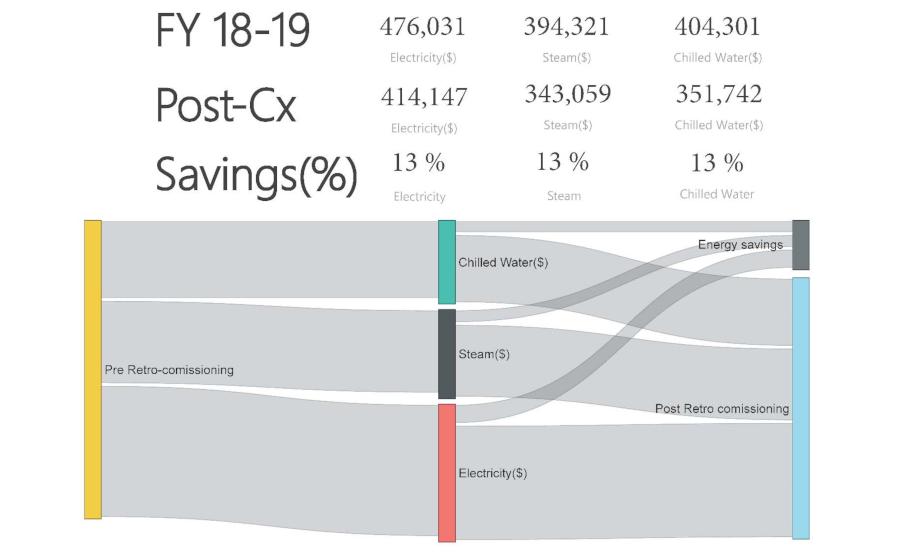
Energy use prior to the start of work compared to the estimated energy use following commissioning activities for FSU’s King Life Sciences building.
King Life Sciences Building
The team recalibrated instrumentation and retrofitted fume hoods with sash position sensors to allow the implementation of reduced airflow rates. The performance of the sash position sensors was then verified through functional testing. The approved RLS forms documented a record of updated air change rates and associated air flow set points. The team also converted existing constant volume fume hoods to two-position flow control with sash position switches. The outcome is a substantial reduction in fume hood airflow rates, which also cascades into supply airflow in rooms with multiple fume hoods. As a result of the commissioning activities and adjustments implemented in this project, the ventilation system was optimized, and the energy used by the HVAC systems in the building has been reduced. Recalibration of control system components, replacement of failed devices, and reducing air change set points drives down the energy used by supply and exhaust fans, chilled and hot water pumps, and primary chilled water and steam systems. The illustration below shows anticipated energy savings of 13% based on existing utility information and estimates of future performance.
A total of 311 issues were identified during the retro-commissioning efforts at the King Life Sciences building, including unoccupied airflow rates that exceeded occupied airflow rates, incorrect air balance and pressurization, and incorrect control system graphic display. Issues were categorized according to the root cause and type of corrective action required for each. All issues identified during the retro-commissioning activities, both resolved issues that have already been closed and unresolved issues that are still open, are listed and categorized in Figure 3.
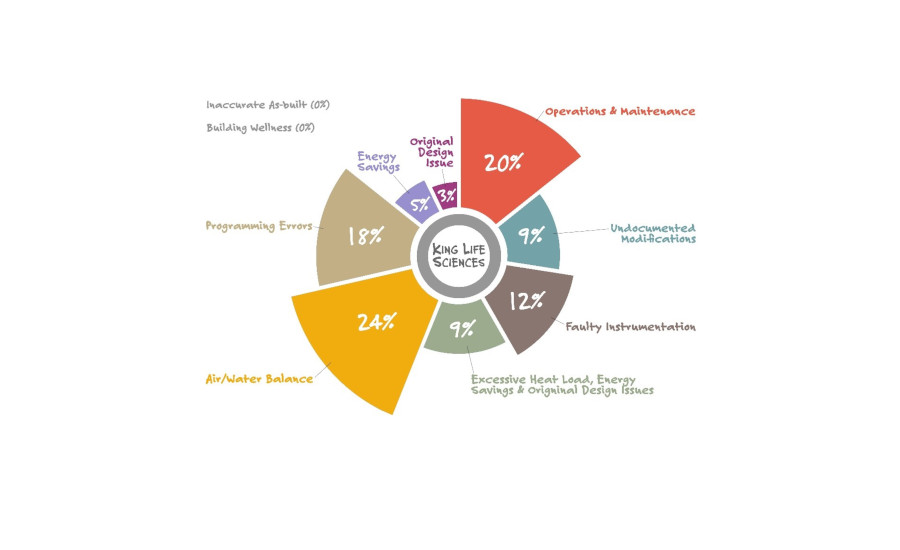
A categorization of issues by root cause at the King Life Sciences building.
Categories in Figure 3 were defined according to the following rationale:
Excessive Heat Load — Current load in the area exceeds the original design intent (refrigerators, freezers, computers, and other heat-producing equipment in excess of what was originally planned for);
Energy Savings — Energy conversation measure;
Building Wellness — This is an opportunity to improve IAQ or prevent future IAQ issues;
Undocumented Design Modifications — Additions/modifications to the HVAC systems that are not currently documented and will impact system operations;
Operation and Maintenance — Issues that are due to the operational settings of systems or additional maintenance needs that can be resolved by the facilities/maintenance staff;
Air Balance/Water Balance — Test and balance effort needed to correct the issue;
Programming Incomplete/Errors — Issues found within the building automation software;
Design Issues: Issues found with the original design when compared to current best practices;
Future Capital Improvement — Opportunities outside the scope of the project;
As‐builts — Actual installation varies from as-built documentation; and
Control Instrumentation — Devices out of calibration or not working properly, including controllers, field panels, etc.
As a result of the retro-commissioning process, 221 of these items were resolved. Resolution of the remaining items is pending repairs to equipment or corrective actions, such as modifications to ductwork. Accordingly, these issues were reviewed in detail with FSU and designated as outstanding issues yet to be resolved, complete with technical recommendations as appropriate.
College of Engineering Buildings A and B
The relatively small number of wet lab spaces in these buildings, combined with the low preexisting air change rates, resulted in a limited potential for reducing the HVAC energy use. The academic and research programs associated with the college of engineering only generally necessitate dry-lab spaces, computer labs, and engineering shops. Commonly accepted practice allows air within spaces of this type to be recirculated and allows for a lower air change rate since open chemical use is not present. Recalibration of control system components and replacement of failed devices did however ensure the HVAC systems will achieve acceptable performance, operate reliably, and reduce maintenance needs. Although these activities do not directly reduce the energy use in the building, energy use may be reduced indirectly because of improved performance.
A total of 148 issues were identified during the retro-commissioning efforts in Buildings A and B at the college of engineering. All issues identified during the retro-commissioning activities, both resolved issues that have already been closed and unresolved issues that are still open, are listed and categorized in Figure 4.
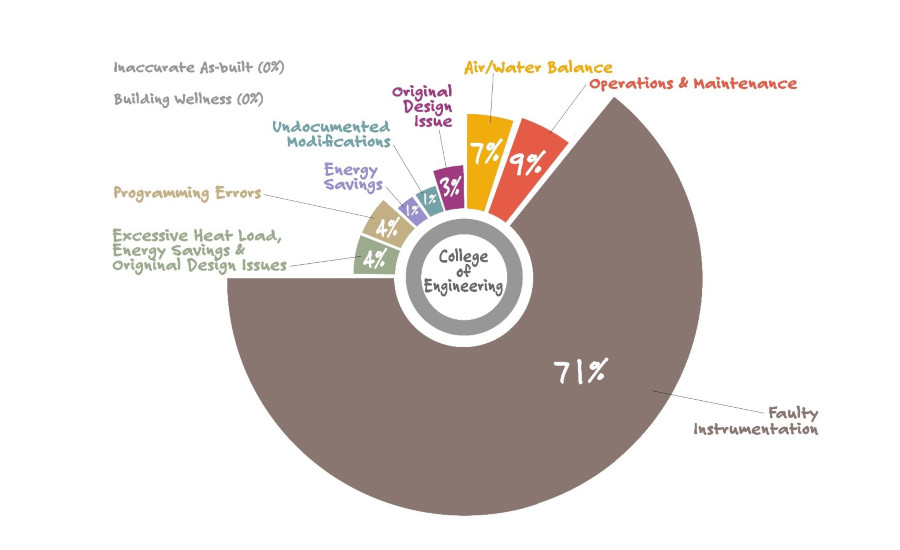
A categorization of issues by root cause for Buildings A and B at the college of engineering.
A total of 47 of these items were resolved over the course of the retro-commissioning process. A large percentage of the issues identified were related to failed components, such as faulty dampers, and, as such, were beyond the scope of this project. This type of issue was reviewed in detail with FSU and documented as outstanding and yet to be resolved, complete with technical recommendations as appropriate.
Two of the largest contributors of issues in both facilities were faulty instrumentation and the ever-increasing burden on operations and maintenance (O&M) groups to maintain such complex systems. Shortages of an available and trained labor force appears as a larger trend throughout the industry, also extending into the construction sector as evidenced partially by the data from the King Life Sciences building. These factors point to an increased need for simplicity in system design, intelligent building solutions, improved fault diagnosis/detection, periodic retro-commissioning efforts, and additional training.
Conclusion
The retro-commissioning activities summarized herein represent a pragmatic approach to optimizing laboratory system performance by identifying and documenting modifications to original designs; verifying existing configuration of lab room ventilation equipment, flows, and pressures as well as implementing adjustments to air change rates. In many cases, the process could however be made more efficient by engaging consultants in the pre-planning process to identify and screen facilities under consideration for retro-commissioning. Ensuring that as-built drawings are up to date during the pre-planning stage would reduce time delays during the execution of the project. As an additional lesson learned, the project team originally anticipated all issues would be resolved prior to making any adjustments; in practice there were open, unresolved issues resulting from limitations, such as parts or technician availability, that were resolved concurrently with the adjustments in order for the project to remain on schedule. Creating a quick response O&M staff or attaching service providers with the retro-commissioning team would streamline this process. Similarly, formally integrating work order generation into the retro-commissioning process could reduce the time required to resolve issues.
These case studies of retro-commissioning efforts at two facilities provide examples and lessons learned for a systematic approach to planning, assessing, and optimizing existing lab facilities. Benchmarking activities for these buildings also identified other lab facilities at FSU that could potentially benefit from this type of effort in the future as part of FSU’s progression toward high-performance labs. In conclusion, this approach can be tailored to meet the needs of specific lab programs and client types to reduce energy costs, increase safety, and renew systems in a wide range of existing lab facilities.




